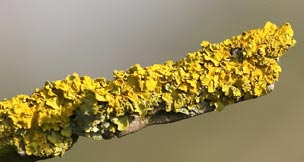If you are bringing twigs or branches in to decorate your house for Christmas, be aware that any lichen might be occupied with unexpected guests. Apart from spiders and assorted small insects secreted away amongst the lichens’ folds, the caterpillars of several moth species feed on lichens (as well as algae).
What are lichens?
Lichens are commonly associated with ancient woodland and gravestones. There are around 1,800 species in the British Isles, in colours from grey-green to orange and various forms such as shrubby, leafy and crusty. Some of these lichens could be found in your garden on trees, shrubs, rocks, paving stones, walls and fences.
A lichen is not a single organism, it is a stable association between a fungus and one or more partners called photobionts. These photobionts are algae or, less frequently, cyanobacteria, both of which produce simple sugars by photosynthesis that are then absorbed by the fungus. The symbiotic relationship is thought to be mutually beneficial to both partners as the fungus creates the structure of the lichen and the photobionts have a protected place to live. Lichens also extract water and other nutrients, such as nitrogen, from the air.
Lichens are slow growing and are poor dispersers. They may be more common on plants which lack vigour but they don’t cause any damage. Lichens prefer humid, damp and still conditions. They are also affected by pollution so are found in clean-air habitats and some are thriving now that there is no acid rain due to lower emissions of sulphur dioxide from industry. Statistics from the National Moth Recording Scheme have shown that there has also been an increase in some of the moth species that feed on lichens, against a background of general moth declines.
Moth species
 The main group of species, whose caterpillars feed on lichens or algae, are the footman moths, some of which could be found in gardens in various parts of the UK.
The main group of species, whose caterpillars feed on lichens or algae, are the footman moths, some of which could be found in gardens in various parts of the UK.
Many moths that use lichens as foodplants spend the winter as small caterpillars. The moths listed below are in this life cycle stage from August to May or June. They then pupate in a cocoon formed in a crevice or amongst lichen or plant debris. The adults are mainly on the wing between June or July and August.
Dingy Footman is one of the moths whose population levels have increased spectacularly and distribution has expanded since the1970s. The caterpillars feed on various lichens and algae growing on trees and bushes. The moth is fairly common in the southern half of England and Wales.
Buff Footman caterpillars feed on lichens and algae on the branches of trees and shrubs, including oaks, birches, hawthorns and conifers such as spruces and Yews. This species is locally common in the south of England and Wales, and parts of Ireland.
The caterpillars of Common Footman moths feed on various lichens and algae on trees, bushes, posts, walls and rocks. This species is widespread in most of the UK, except in Scotland where it is local.
Muslin Footman caterpillars feed on lichens on stone walls, rocks, posts and isolated bushes. In the spring they bask in sunshine or rest under a stone. This species occurs in scattered locations throughout much of the UK
Rosy Footman moths have attractive orange or pinkish forewings with black wavy lines. The caterpillars feed on Dog Lichen and other lichens growing on the trunks and twigs of oaks and other trees. They will continue to feed in mild weather during the winter. They occur in the southern half of the UK.
Scarce Footman caterpillars consume lichens and algae on rocks, walls, posts, plant stems and branches. They are found in England, mainly in the south and east, and in Wales and Ireland where it is more coastal.
In addition to the footman moths, there are two other species which you could find in your garden. Brussels Lace caterpillars resemble the lichen they consume on the branches and stems of woody plants and sometimes on rocks and walls. The moth is fairly common in south-west England, south Wales and Ireland, but rare in other parts of England, and is locally distributed in Scotland.
 Dotted Carpet adults are very well camouflaged against lichen-covered trees. The caterpillars are bright green with large black dots and feed on various lichens, including the newest growth of Beard Lichen. They occur in a range of sites, mainly in south-west England and Wales and parts of Scotland.
Dotted Carpet adults are very well camouflaged against lichen-covered trees. The caterpillars are bright green with large black dots and feed on various lichens, including the newest growth of Beard Lichen. They occur in a range of sites, mainly in south-west England and Wales and parts of Scotland.
It is also possible that adult moths could be hiding amongst the lichens now. Some adult moths, such as the Mottled Umber have colours and patterns on the wings which allow them to be well camouflaged when resting on lichen-covered tree trunks or stones, so making them less likely to be eaten by birds and other predators.
At this time of year, with bare branches on trees, lichens are more noticeable so this is a great time to observe other habitat diversity in your garden.
Happy Christmas!
The Secret Gardener


